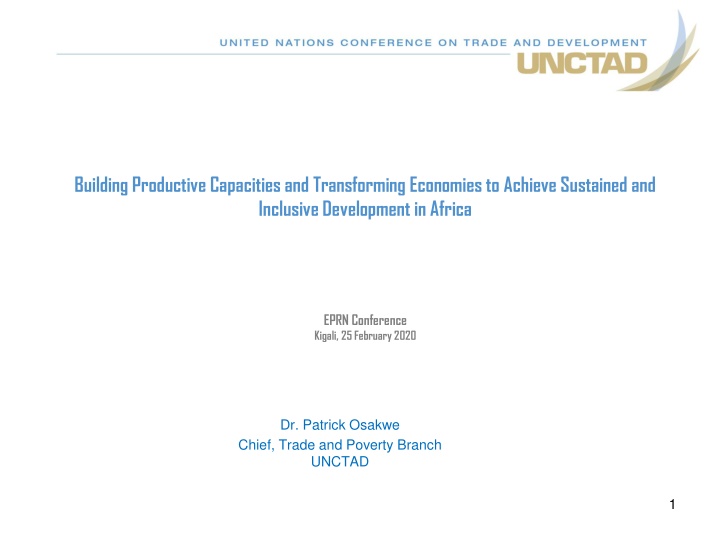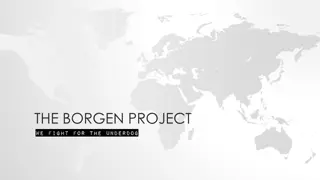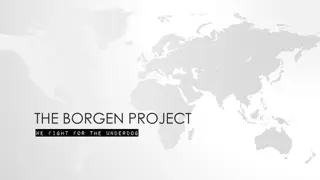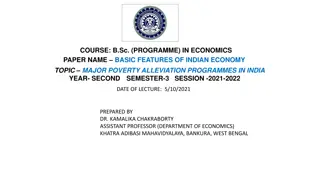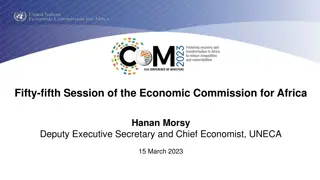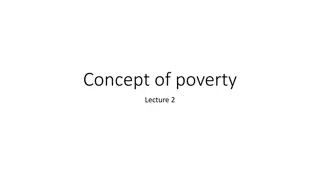Addressing Poverty through Developing Productive Capacities in Africa
Global poverty is a pressing issue in Africa, despite reductions in other regions. The necessity to build productive capacities and create sustainable employment opportunities to combat poverty is emphasized. African countries must diversify their economies and enhance productive resources to drive inclusive development. Understanding the concept of productive capacity is crucial in addressing poverty challenges effectively.
Download Presentation

Please find below an Image/Link to download the presentation.
The content on the website is provided AS IS for your information and personal use only. It may not be sold, licensed, or shared on other websites without obtaining consent from the author.If you encounter any issues during the download, it is possible that the publisher has removed the file from their server.
You are allowed to download the files provided on this website for personal or commercial use, subject to the condition that they are used lawfully. All files are the property of their respective owners.
The content on the website is provided AS IS for your information and personal use only. It may not be sold, licensed, or shared on other websites without obtaining consent from the author.
E N D
Presentation Transcript
Building Productive Capacities and Transforming Economies to Achieve Sustained and Inclusive Development in Africa EPRN Conference Kigali, 25 February 2020 Dr. Patrick Osakwe Chief, Trade and Poverty Branch UNCTAD 1
1. Global poverty is increasingly concentrated in Africa Over the past three decades there has been a significant reduction in global poverty Poverty headcount ratio (at $1.90) fell from 35.9 percent in 1990 to 10 percent in 2015 The decline in global poverty due mostly to significant declines in populous regions of East Asia and the Pacific and South Asia In sub-Saharan Africa, the poverty rate fell from 55 percent in 1990 to 41 percent in 2015. In 2015 the poverty rate was 51 percent in Rwanda, 62 percent in Mozambique, 70 percent in Malawi, 73 percent in South Sudan, and 78 percent in Madagascar.
Although the poverty rate declined, the number of poor in Africa increased The number of poor people in sub-Saharan Africa increased from 278 million in 1990 to 412 million in 2015. But global poverty fell from 1896 million to 734 million over the same period. Consequently, there has been an increase in sub-Saharan Africa s share of global poverty from 15 percent in 1990 to 56 percent in 2015. Figure: Number of people who live below $1.90 2000 1896 1800 1600 1400 1200 1087 1000 800 734 600 412 400 403 279 200 0 1990 2010 2015 World sub-Saharan Africa
2. Addressing the challenge of poverty reduction in Africa requires developing productive capacities Creation of decent jobs on a sustained basis is needed to accelerate the pace of poverty reduction in Africa Productive capacity development is key to employment creation But African countries have very weak productive capacities manufacturing plays very limited role in African economies growth driven by the extractive industries, which are capital intensive Need to broaden the sources of growth in Africa
What is productive capacity? a) UNIDO: The ability to produce goods that meet the quality requirements of present markets and to upgrade in order to tap future markets. b) UNCTAD: The productive resources, entrepreneurial capabilities and production linkages which together determine the capacity of a country to produce goods and services and enable it to grow and develop. Bottom Line: There is no generally-agreed definition It simply captures what a country is able to produce efficiently and competitively 5
Productive resources -human resources Productive Capacities -natural resources -physical capital Firm capabilities -organizational -technological Production linkages -backward and forward -domestic and foreign firms -small and large firms 6
3. The discourse on productive capacities must shift from the WHAT and WHY to the HOW Questions Three sets of questions are often posed in discussions on productive capacities: WHAT does it mean? WHY is it important? HOW can it be developed AND How can progress be measured? So far, there has been more focus on the WHAT and the WHY questions rather than on the HOW. For example, policymakers do not have relevant tools to measure the state of productive capacities UNCTAD is developing an index to assist policymakers in monitoring the development of productive capacities
4. A holistic approach to developing productive capacities is needed in Africa Developing productive capacities requires addressing two equally important issues: building new capacities; and utilizing and maintaining existing capacities. Policy discussions focus more on building new capacities than on utilizing and maintaining existing ones. Building new capacities is meaningless when existing ones are neither maintained nor utilized. While the medium to long term goal is to build capacities, in the short term the focus should be on how to maintain and utilize existing capacities 8
Manufacturing capacity utilization rates in selected countries 100% 90% 85.8% 81.8% 80% 73.0% 72.2% 70% 66.9% 66.5% 63.6% 62.0% 60.0% 60% 56.0% 50% National WBES 40% 30% 20% 10% 0% 2010 2011 2013 2014 2007 2006 2011 2007 Ethiopia Kenya Nigeria Rwanda South Africa 9
Reasons for low manufacturing capacity utilization RWANDA Low domestic demand ETHIOPIA Shortage of raw materials Unreliable supply of inputs KENYA SOUTH AFRICA Low demand Lack of adequate working capital Low domestic demand Volatile demand Absence of credit facilities NIGERIA Lack of skilled labour High cost of electricity Downtime due to maintenance and seasonal factors High cost of imported raw materials and inputs Shortage of foreign exchange High cost of materials Delays in sourcing inputs Shortage of raw materials Unreliable power supply Lack of adequate skills Lack of adequate financing for purchasing inputs Lack of skilled labour Shortage of skilled labour Low domestic demand 10
5. Productive transformations are created through smart and pragmatic industrial policies Productive capacities and economic transformation do not take place in isolation They are created through industrial policies involving: supporting firms and holding them accountable for non-performance lifting binding constraints on firm entry and growth strengthening linkages between manufacturing and other sectors developing technological capabilities of domestic firms Some key policy areas crucial for transformation include: monetary and fiscal policies, technical and vocational skills development, local content policies, investment policies, special economic zones, trade policies, etc
6. African consumers should play a positive role in productive transformation Discussions on productive capacities tend to focus on government policies and the activities of the private sector But consumer behavior is also important in achieving goals on transforming production and exports The consumption patterns and tastes of consumers have an impact on the types of goods that can be profitably produced and traded by domestic entrepreneurs. Wine industry in Switzerland Beer industry in West Africa
